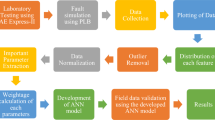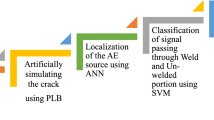Abstract
The sensor-based Acoustic Emission (AE) technique is widely used for detecting structural damages to prevent catastrophic failure in real time. However, this approach can be further improved by incorporating soft computing approaches such as Artificial Neural Network (ANN). An ANN-based AE approach for damage detection can be a more energy-efficient alternative to existing Non-destructive tests (NDT) for huge railway systems throughout the globe. This study aims to develop an energy-efficient soft computing-based approach using surface wave propagation of AE signal simulation and ANN for the smart diagnosis of rail defects. The study uses Pencil Lead Break (PLB) as an artificial AE source to generate an AE signal equivalent to damage in microscale at various distances over the Top Flange (TF) along the rail section. A single AE sensor is mounted in the middle of the web of the rail section to obtain the simulated AE signal. The AE parameters viz. Counts, Energy, Amplitude, etc. obtained from the AE signals are used to develop an ANN model, where defect location is considered as an output of the model for localization of AE source/ defect in the rail section. The developed ANN model is tested for predicting the defect location and found to be efficient, with an error of less than 1%. This model can be a potential energy-efficient approach for sensor-based smart diagnosis of defects in the rail section in real time.







Similar content being viewed by others
Data availability
Data may be available on request for research purpose without violating the future scope. For this purpose, researchers can contact the corresponding author.
References
Ai, L., Soltangharaei, V., Bayat, M., Greer, B., & Ziehl, P. (2021). Source localization on large-scale canisters for used nuclear fuel storage using optimal number of acoustic emission sensors. Nuclear Engineering and Design, 375, 111097. https://doi.org/10.1016/j.nucengdes.2021.111097
Ativitavas, N., Fowler, T., & Pothisiri, T. (2004). Acoustic emission characteristics of pultruded fiber reinforced plastics under uniaxial tensile stress. In: Proceedings of European WG on AE, 447–454. Berlin, (2004). DGZfP-Proceedings BB 90-CD(EWGAE 2004).
Bassim, M. N. (1992). Detection of fatigue crack propagation with acoustic emission. NDT & E International, 25(6), 287–289. https://doi.org/10.1016/0963-8695(92)90639-X
Bombarda, D., Vitetta, G. M., & Ferrante, G. (2021). Rail diagnostics based on ultrasonic guided waves: An overview. Applied Sciences, 11(3), 1071. https://doi.org/10.3390/app11031071
Cheng, L., Xin, H., Groves, R. M., & Veljkovic, M. (2021). Acoustic emission source location using lamb wave propagation simulation and artificial neural network for I-shaped steel girder. Construction and Building Materials, 273, 121706. https://doi.org/10.1016/j.conbuildmat.2020.121706
Chlada, M., Prevorovsky, Z., & Blahacek, M. (2010). Neural network AE source location apart from structure size and material. Journal of Acoustic Emission, 28(1), 99–108.
Clark, R. (2004). Rail flaw detection: Overview and needs for future developments. Ndt & E International, 37(2), 111–118. https://doi.org/10.1016/j.ndteint.2003.06.002
Danesh, M. (2019). Evaluation of seismic performance of PBD optimized steel moment frames by means of neural network. Jordan Journal of Civil Engineering, 13(3), 472–488.
De Almeida, V. A. D., Baptista, F. G., & De Aguiar, P. R. (2014). Piezoelectric transducers assessed by the pencil lead break for impedance-based structural health monitoring. IEEE Sensors Journal, 15(2), 693–702. https://doi.org/10.1109/JSEN.2014.2352171
Dris, E. Y., Drai, R., Benammar, A., & Berkani, D. (2017). acoustic emission source localization in plate-like structure. 2017 European conference on electrical engineering and computer science (EECS), Bern, Switzerland, 193–197. Doi: https://doi.org/10.1109/EECS.2017.44.
Ebrahimkhanlou, A., & Salamone, S. (2018). Single-sensor acoustic emission source localization in plate-like structures using deep learning. Aerospace, 5(2), 50. https://doi.org/10.3390/aerospace5020050
Guo, Z., Li, Z., Han, C., & Yang, G. (2022). Research on bearing oil film condition monitoring based on acoustic emission parameters. International symposium on control engineering and robotics (ISCER), Changsha, China, 143–147. doi: https://doi.org/10.1109/ISCER55570.2022.00031.
Kalafat, S., & Sause, M. G. (2015). Acoustic emission source localization by artificial neural networks. Structural Health Monitoring., 14(6), 633–647. https://doi.org/10.1177/1475921715607408
Kaveh, A., Gholipour, Y., & Rahami, H. (2008). Optimal design of transmission towers using genetic algorithm and neural networks. International Journal of Space Structures, 23(1), 1–19. https://doi.org/10.1260/026635108785342073
Kaveh, A., & Iranmanesh, A. (1998). Comparative study of backpropagation and improved counterpropagation neural nets in structural analysis and optimization. International Journal of Space Structures, 13, 177–185. https://doi.org/10.1177/026635119801300401
Kaveh, A., & Khalegi, A. (1998). Prediction of strength for concrete specimens using artificial neural network. Asian Journal of Civil Engineering, 2(2), 1–13.
Kaveh, A., & Khavaninzadeh, N. (2023). Efficient training of two ANNs using four meta-heuristic algorithms for predicting the FRP strength. Structures, 52, 256–272. https://doi.org/10.1016/j.istruc.2023.03.178
Kaveh, A., & Servati, H. (2001). Design of double layer grids using backpropagation neural networks. Computers & Structures, 79(17), 1561–1568. https://doi.org/10.1016/S0045-7949(01)00034-7
Kharrat, M., Placet, V., Ramasso, E., & Boubakar, M. L. (2018). Influence of damage accumulation under fatigue loading on the AE-based health assessment of composite materials: Wave distortion and AE-features evolution as a function of damage level. Composites Part a: Applied Science and Manufacturing, 109, 615–627. https://doi.org/10.1016/j.compositesa.2016.03.020
Kim, K. B., Yoon, D. J., Jeong, J. C., & Lee, S. S. (2004). Determining the stress intensity factor of a material with an artificial neural network from acoustic emission measurements. NDT & E International, 37(6), 423–429. https://doi.org/10.1016/j.ndteint.2003.08.007
Kostryzhev, A. G., Davis, C. L., & Roberts, C. (2013). Detection of crack growth in rail steel using acoustic emission. Ironmaking & Steelmaking, 40(2), 98–102. https://doi.org/10.1179/1743281212Y.0000000051
Kuang, K. S. C., Li, D., & Koh, C. G. (2016). Acoustic emission source location and noise cancellation for crack detection in rail head. Smart Structures and Systems, 18(5), 1063–1085. https://doi.org/10.12989/sss.2016.18.5.1063
Kundu, T. (2014). Acoustic source localization. Ultrasonics, 54(1), 25–38. https://doi.org/10.1016/j.ultras.2013.06.009
Kundu, T., Datta, A. K., Topdar, P., & Sengupta, S. (2022). Optimal location of acoustic emission sensors for detecting rail damage. Proceedings of the Institution of Civil Engineers-Structures and Buildings. https://doi.org/10.1680/jstbu.21.00074
Kundu, T., Pal, A., Roy, P., Datta, A. K., & Topdar, P. (2022b). Application of UPV-instrument in health monitoring of Indian rail section using AE technique. In: ASPS Conference Proceedings, 1:5, 1429–1439. https://doi.org/10.38208/acp.v1.673.
Kundu, T., Roy, P., Datta, A. K., & Topdar, P. (2022c). Health monitoring of Indian rail section using AE technique combined with UPVM: An experimental study. Journal of Structural Engineering, 49(1), 1–11.
Mahar, N., & Podder, D. (2021). Damage detection in RC beam utilizing feed-forward backpropagation neural network technique. Asian J Civ Eng, 22, 1551–1561. https://doi.org/10.1007/s42107-021-00396-7
Marais, J. J., & Mistry, K. C. (2003). Rail integrity management by means of ultrasonic testing. Fatigue & Fracture of Engineering Materials & Structures, 26(10), 931–938. https://doi.org/10.1046/j.1460-2695.2003.00668.x
Murav’ev, V. V., Murav’ev, M. V., & Murav’ev, T. V. (2008). The possibilities of acoustic emission testing of rails during exploitation. Russian Journal of Nondestructive Testing, 44(1), 33–40. https://doi.org/10.1134/S106183090801004X
Sengupta, S., Datta, A. K., & Topdar, P. (2015). Structural damage localisation by acoustic emission technique: A state of the art review. Latin American Journal of Solids and Structures., 12, 1565–1582. https://doi.org/10.1590/1679-78251722
Suwansin, W., & Phasukkit, P. (2021). Deep learning-based acoustic emission scheme for rail crack monitoring. 16th International Joint Symposium on Artificial Intelligence and Natural Language Processing (iSAI-NLP), Ayutthaya, Thailand, 2021, 1-5. doi: https://doi.org/10.1109/iSAI-NLP54397.2021.9678162
Tefera, B., Zekaria, A., & Gebre, A. (2023). Challenges in applying vibration-based damage detection to highway bridge structures. Asian J Civ Eng. https://doi.org/10.1007/s42107-023-00594-522
Wevers, M. (1997). Listening to the sound of materials: Acoustic emission for the analysis of material behaviour. Ndt & E International, 30(2), 99–106. https://doi.org/10.1016/S0963-8695(96)00051-5
Zhang, X., Feng, N., Wang, Y., & Shen, Y. (2014). An analysis of the simulated acoustic emission sources with different propagation distances, types and depths for rail defect detection. Applied Acoustics, 86, 80–88. https://doi.org/10.1016/j.apacoust.2014.06.004
Zhang, X., Zou, Z., Wang, K., Hao, Q., Wang, Y., Shen, Y., & Hu, H. (2018). A new rail crack detection method using LSTM network for actual application based on AE technology. Applied Acoustics, 142, 78–86. https://doi.org/10.1016/j.apacoust.2018.08.020
Acknowledgements
The study is supported by DST-TSDP, Government of India. The authors are thankful to the Section Engineer, Durgapur, E-RLY, Indian Railway for providing the rail section which is used for this study.
Funding
The author(s) declare that no funds, grants, or other financial support were received for the research, authorship and/or publication of this article.
Author information
Authors and Affiliations
Contributions
Apurba Pal and Tamal Kundu conducted the experiment and wrote the manuscript. Dr. Aloke Kumar Datta reviewed the manuscript and supervised the experiment.
Corresponding author
Ethics declarations
Conflict of interest
The author(s) declared no potential conflicts of interest with respect to the research, authorship and/or publication of this article.
Additional information
Publisher's Note
Springer Nature remains neutral with regard to jurisdictional claims in published maps and institutional affiliations.
Rights and permissions
Springer Nature or its licensor (e.g. a society or other partner) holds exclusive rights to this article under a publishing agreement with the author(s) or other rightsholder(s); author self-archiving of the accepted manuscript version of this article is solely governed by the terms of such publishing agreement and applicable law.
About this article
Cite this article
Pal, A., Kundu, T. & Datta, A.K. Sensor-based smart diagnosis of rail defects using an ann model. Asian J Civ Eng 24, 3001–3008 (2023). https://doi.org/10.1007/s42107-023-00690-6
Received:
Accepted:
Published:
Issue Date:
DOI: https://doi.org/10.1007/s42107-023-00690-6




